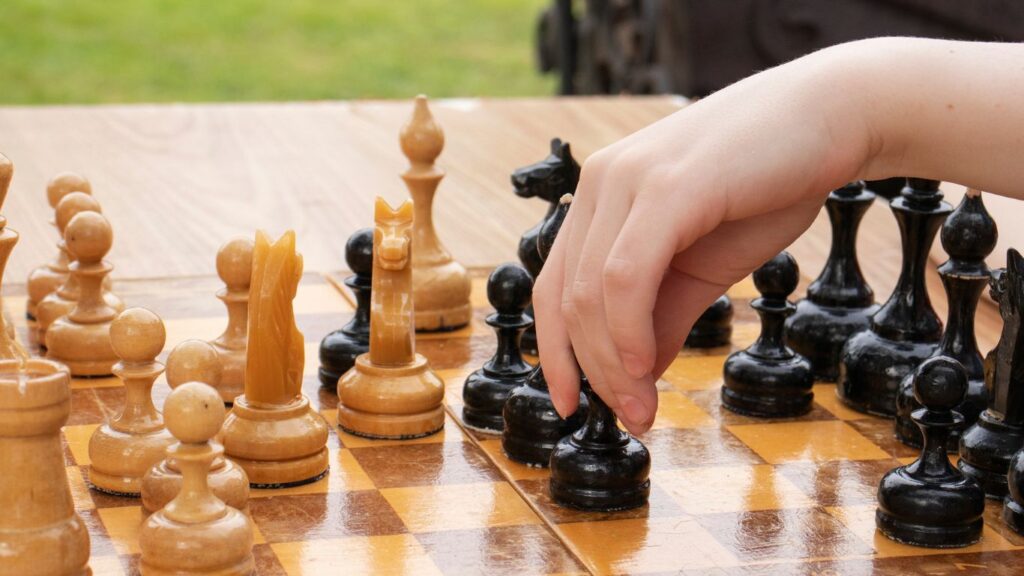Welcome to the fascinating world of chess! Mastering the basics is essential whether you’re just starting or looking to sharpen your skills. This guide will introduce you to key strategies that every beginner should know: controlling the centre, developing your pieces, and ensuring king safety. Let’s dive in and make your journey from novice to enthusiast rewarding and enjoyable.
Setting Up the Board and Pieces
Before we delve into strategies, it’s essential to understand how to set up the chessboard correctly. Place the board so each player has a white square on the right-hand corner. The second row from each player is filled with pawns, bishops are next to the knights, queens are placed on their colour (white queen on the white, black queen on black), and kings take the remaining squares next to the queens.
Learning the Movement of Each Piece

Familiarize yourself with the movement of each piece:
- Pawns: Move forward one square capture diagonally.
- Knights: Move in an “L” shape.
- Bishops: Move diagonally any number of squares.
- Rooks: Move horizontally or vertically any number of squares.
- Queens: Move horizontally, vertically, or diagonally any number of squares.
- Kings: Move one square in any direction.
Importance of Controlling the Center
One of the foundational principles in chess is controlling the centre of the board, specifically the squares e4, e5, d4, and d5. Controlling these squares allows you to move your pieces more freely and restricts your opponent’s options.
Example:
- Opening with 1.e4 or 1.d4 helps to control the centre and prepares your other pieces for development.
Scenario:
After 1.e4 e5, you can follow up with 2.Nf3, attacking the e5 pawn and preparing for further central control.
Strategies for Developing Your Pieces

Developing your pieces means moving them from their starting positions to more active squares where they can control more territory and contribute to your overall strategy. Knights and bishops should generally be developed before rooks and queens.
Example:
- In the Italian Game: 1.e4 e5 2.Nf3 Nc6 3.Bc4, White develops a knight and a bishop, aiming for rapid piece activity.
Scenario:
After playing 1.e4 e5 2.Nf3 Nc6, developing knights to f3 and c3, and bishops to c4 or f4, opens up lines for attack and defence.
Utilizing Tactics to Gain Advantage
Tactics are short-term sequences of moves that result in material gain or other strategic advantages. Common tactics include forks, pins, and skewers.
Center Control Exercise:
- Present a starting board and ask the user to identify and move the pieces to control the central four squares.
- Example: Starting position – e4, e5, Nf3, Nc6. The user is asked to move to control the centre further, such as 3.d4.
King Safety
King’s safety is paramount. Castling is a special move that improves king safety by moving the king to a corner and bringing a rook into play.
Example:
- After 1.e4 e5 2.Nf3 Nc6 3.Bb5 a6 4.Bxc6, white castles kingside, ensuring the king is secure behind a wall of pawns.
Scenario:
It’s a game where one side has yet to castle while the other has. Show how the castled side is better protected from attacks.
King Safety Challenge:
- Present a position where one side has not castled, and the other has, with an impending attack. The user identifies the importance of king safety and the value of castling.
- Example: Display a board with one side castled and the other not. Propose a scenario where the uncastled king falls victim to a series of checks, highlighting the necessity of early castling.
Practical Examples
Control the Center:
- Italian Game: After 1.e4 e5 2.Nf3 Nc6 3.Bc4, White establishes a strong presence in the centre and frees up the bishop on c1.
- Queen’s Gambit: In the opening moves 1.d4 d5 2.c4, White aims to control the centre with the d4 pawn, ready to develop pieces behind it.
Develop Your Pieces:
- Fried Liver Attack: Demonstrates aggressive piece development with 1.e4 e5 2.Nf3 Nc6 3.Bc4 Nf6 4.Ng5 d5 5.exd5 Nxd5, where White sacrifices a knight to exploit Black’s underdeveloped position.
- Ruy Lopez: Shows the principle of developing bishops and knights to active squares with the moves 1.e4 e5 2.Nf3 Nc6 3.Bb5 a6 4.Ba4 Nf6 5. O-O, leading to a solid central presence for both sides.
King Safety:
- Four-Move Checkmate: A quick game highlighting the importance of early king safety. Black falls victim to the four-move checkmate (1.e4 e5 2.Qh5 Nc6 3.Bc4 Nf6 4.Qxf7#) for not protecting the f7 square.
- Castling to Safety: In a longer game, the players demonstrate the value of casting early to secure the king. For example, after 1.e4 e5 2.Nf3 Nc6 3.Bb5 a6 4.Ba4 Nf6 5. O-O, both sides prioritize king safety by castling kingside.
Frequently Asked Questions (FAQs)
- What is the best opening move for beginners?
The best opening move for beginners is often considered 1.e4 or 1.d4. These moves aim to control the centre of the board, allowing for easier development of other pieces.

- How important is castling in chess?
Castling is crucial for the king’s safety. It moves the king into a safer position away from the centre and brings the rook into play, enhancing both defence and offence.
- When should I start learning chess tactics?
Learning chess tactics can begin as soon as you are familiar with the basic movements of each piece. Tactics like forks, pins, and skewers are essential for gaining material advantage and should be practised regularly.
- What are common mistakes beginners make?
Common mistakes include moving the same piece multiple times in the opening, neglecting king safety, and ignoring pawn structure. Beginners should focus on developing all their pieces, controlling the centre, and safeguarding their king.
- How can I improve my chess skills?
To improve your chess skills, practice regularly, study classic games, learn standard openings and tactics, and analyze your games to understand your mistakes and learn from them. Playing against more experienced players and using chess puzzles can also be highly beneficial.
- How do I know when to attack?
Knowing when to attack requires understanding the position on the board. Look for weaknesses in your opponent’s position, such as poorly defended pieces, weak pawns, or an exposed king. Understanding tactical patterns and having well-developed pieces can help you launch effective attacks.
- What is the most critical piece in chess?
While all pieces have unique importance, the king is the most crucial since the game’s objective is to checkmate the opponent’s king. Beyond that, the queen is often considered the most potent piece due to its range of movement and ability to influence the game.
- Should I always aim to control the centre of the board?
Yes, controlling the centre is a fundamental principle in chess. It provides greater mobility for your pieces and restricts your opponent’s movement, setting a solid foundation for offence and defence.
- How can I effectively develop my pieces?
Effectively developing your pieces involves moving them to active squares where they can control essential areas of the board. Prioritize developing your knights and bishops early, connect your rooks, and ensure your pieces work harmoniously towards a common strategic goal.
- What resources can I use to further my chess education?
Numerous resources are available, including books, online courses, chess apps, and websites like Chess.com and Lichess.org. Joining a local chess club, participating in tournaments, and learning from experienced players can significantly enhance your skills.
Conclusion: Practicing and Improving Your Game
Understanding these foundational strategies will set you on the path to becoming a stronger chess player. Remember, practice is critical. Regularly playing games, solving puzzles, and reviewing master games will reinforce these concepts and improve your overall game.
Happy playing, and may your journey in chess be both challenging and rewarding!










